
John Warner Barber
Encyclopedia
John Warner Barber was an American engraver whose books of state, national, and local history featured his vivid illustrations, said to have caught the flavor and appearance of city, town, and countryside scenes in his day.
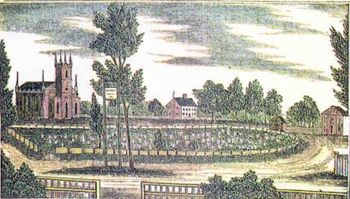
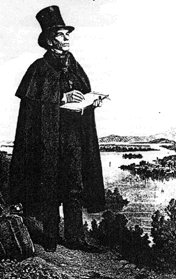 He was born in East Windsor
He was born in East Windsor
, Connecticut
, and learned his craft from the East Windsor printmaker Abner Reed. In 1823 he opened a business in New Haven, where he produced religious and historical books, illustrated with his own wood and steel engravings.
He traveled around Connecticut, creating ink sketches of town greens, hotels, schools, churches, and harbors and collected local history as he went. He also delved into the works of historians. From all this he produced the book now commonly called Connecticut Historical Collections. The full title is Connecticut Historical Collections, Containing a General Collection of Interesting Facts, Traditions, Biographical Sketches, Anecdotes, Etc., Relating to the History and Antiquities of Every Town in Connecticut with Geographical Descriptions.
The book has been called "the first popular local history published in the U.S." The book sold well—7,000 copies in its first year even though it cost three dollars, then an average week's pay. Twelve years later it was reissued and again sold well.
"Today, though his wood engravings are well known, few copies of the book [Connecticut Historical Collections] remain," according to the Bibliopola Press Web site, which, as of August 2006, was selling a reprint version. "Antique dealers unfortunately do a brisk business selling the woodcuts from volumes they have 'broken.'"
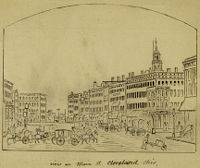 Barber started with rough pencil sketches and developed them into more detailed wash drawings. He then transferred the drawings directly to small blocks of boxwood on which he engraved the designs.
Barber started with rough pencil sketches and developed them into more detailed wash drawings. He then transferred the drawings directly to small blocks of boxwood on which he engraved the designs.
"He talked with townspeople, gathered local documents and made quick sketches everywhere he went," according to a New York Times article from December 10, 1989, quoted on a print-selling Web site. "The illustrations depict each town center, with its homes and churches, academies and courthouses sailboats plying a river or harbor, an occasional factory belching puffs of smoke and always a tiny figure or two, often the artist in his top hat, sketching the scene or pointing to the view."
He died in New Haven in June 1885.
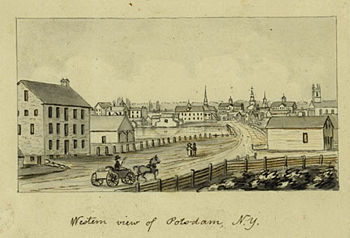

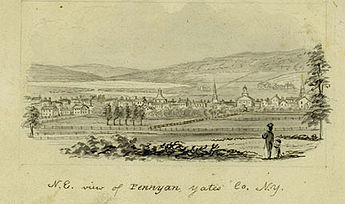


Life

East Windsor, Connecticut
East Windsor is a town in Hartford County, Connecticut, United States. The population was 11,162 at the 2010 census.The town has five villages: Broad Brook, Melrose, Scantic, Warehouse Point and Windsorville.-Area:...
, Connecticut
Connecticut
Connecticut is a state in the New England region of the northeastern United States. It is bordered by Rhode Island to the east, Massachusetts to the north, and the state of New York to the west and the south .Connecticut is named for the Connecticut River, the major U.S. river that approximately...
, and learned his craft from the East Windsor printmaker Abner Reed. In 1823 he opened a business in New Haven, where he produced religious and historical books, illustrated with his own wood and steel engravings.
He traveled around Connecticut, creating ink sketches of town greens, hotels, schools, churches, and harbors and collected local history as he went. He also delved into the works of historians. From all this he produced the book now commonly called Connecticut Historical Collections. The full title is Connecticut Historical Collections, Containing a General Collection of Interesting Facts, Traditions, Biographical Sketches, Anecdotes, Etc., Relating to the History and Antiquities of Every Town in Connecticut with Geographical Descriptions.
The book has been called "the first popular local history published in the U.S." The book sold well—7,000 copies in its first year even though it cost three dollars, then an average week's pay. Twelve years later it was reissued and again sold well.
"Today, though his wood engravings are well known, few copies of the book [Connecticut Historical Collections] remain," according to the Bibliopola Press Web site, which, as of August 2006, was selling a reprint version. "Antique dealers unfortunately do a brisk business selling the woodcuts from volumes they have 'broken.'"

"He talked with townspeople, gathered local documents and made quick sketches everywhere he went," according to a New York Times article from December 10, 1989, quoted on a print-selling Web site. "The illustrations depict each town center, with its homes and churches, academies and courthouses sailboats plying a river or harbor, an occasional factory belching puffs of smoke and always a tiny figure or two, often the artist in his top hat, sketching the scene or pointing to the view."
He died in New Haven in June 1885.
His books
- Historical Scenes in the United States (1827)
- History and Antiquities of New Haven (1831)
- Religious Events (1832)
- Historical Collections of Connecticut (1836)
- Historical Collections of Massachusetts (Worcester, 1839)
- A History of the Amistad Captives, coauthored by E.L. Barber (New Haven, 1840)
- History and Antiquities of New England, New York, and New Jersey (1841)
- Historical Collections of New York, coauthored by Henry Howe, of New Haven (1841)
- Elements of General History (New Haven, 1844)
- Historical Collections of New Jersey, coauthored by Henry Howe, of New Haven (1844)
- Historical Collections of Virginia, coauthored by Henry Howe, of New Haven (1844)
- Incidents in American History (New York, 1847)
- Historical Collections of Ohio, coauthored by Henry Howe, of New Haven (1847)
- Religious Emblems and Allegories (1848)
- Historical, Poetical, and Pictorial American Scenes, coauthored by Elizabeth G. Barber (1850)
- European Historical Collections (1855)
- Our Whole Country, Historical and Descriptive (Cincinnati, 1861)
Footnotes

External links
- A History of the Amistad Captives. New Haven, Ct.: E.L. & J.W. Barber, 1840.
- Guide to John Warner Barber drawings of Massachusetts towns at Houghton Library, Harvard University
- John Warner Barber scrapbook pages, 1832-1868 from the Smithsonian Archives of American ArtArchives of American ArtThe Archives of American Art is the largest collection of primary resources documenting the history of the visual arts in the United States. More than 16 million items of original material are housed in the Archives' research centers in Washington, D.C...




